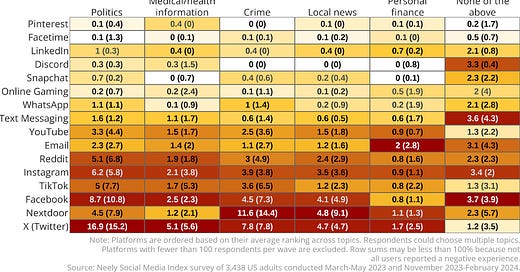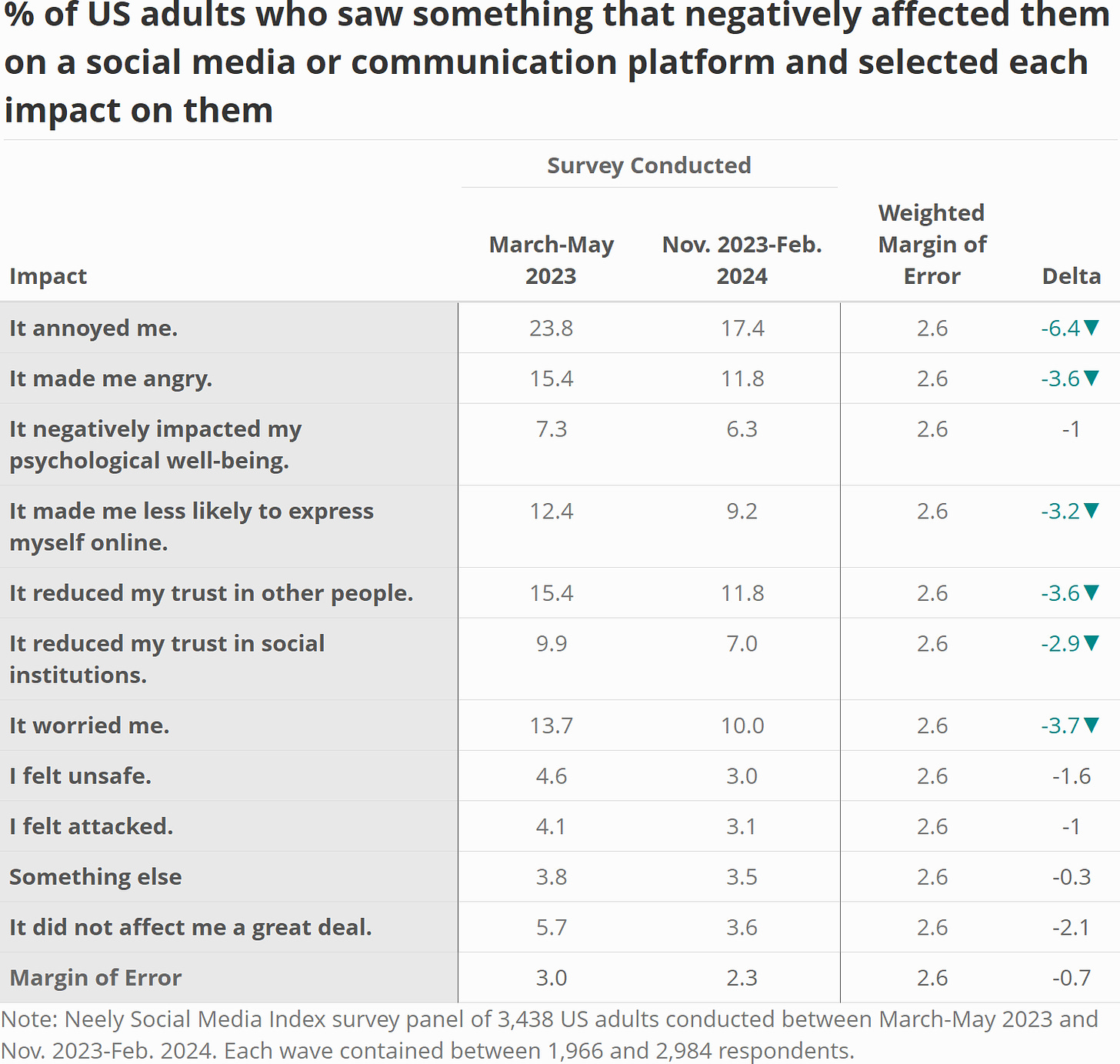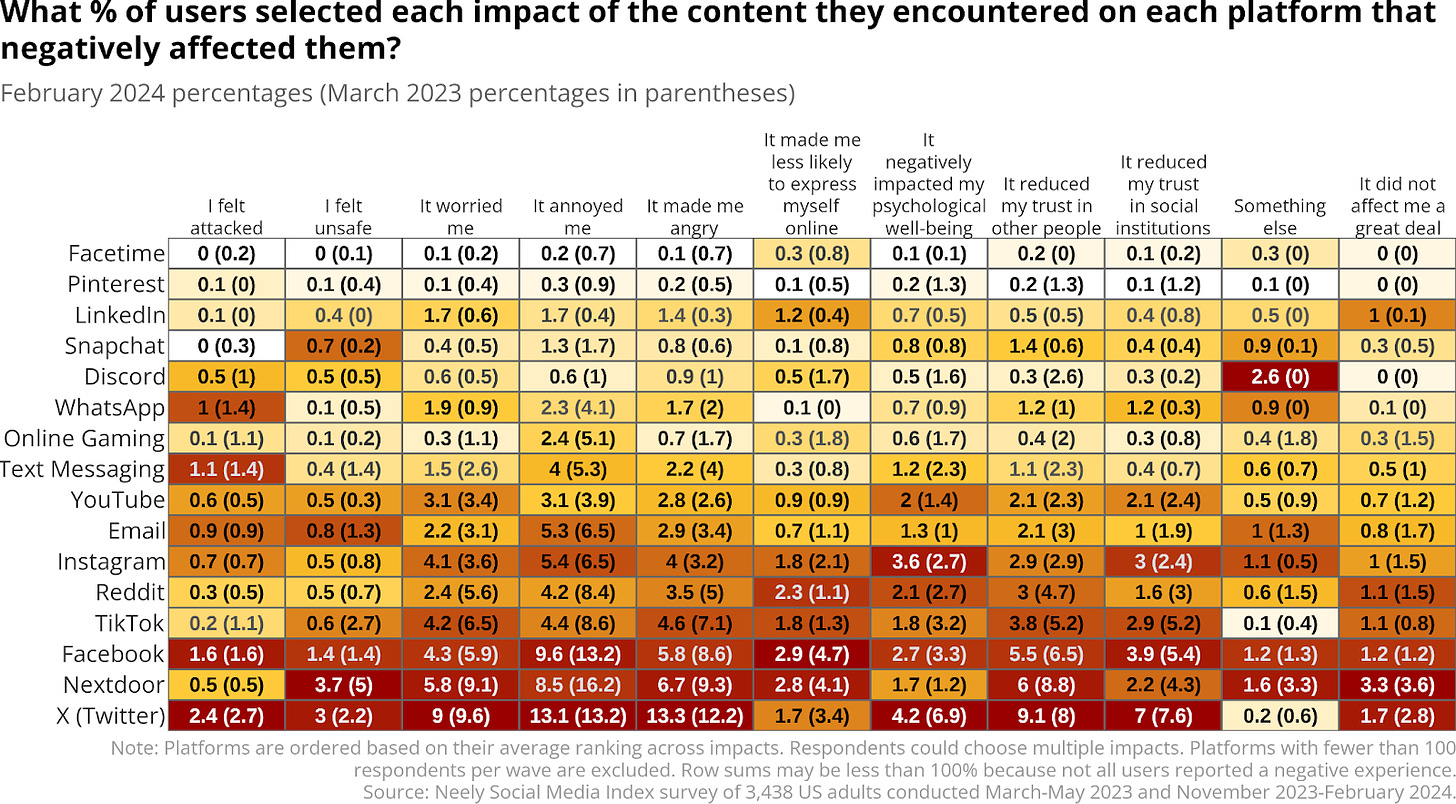How negative experiences on social media changed in the last 12 months
Nextdoor, Facebook, TikTok, and Reddit users report fewer negative experiences today than a year ago; not so much on Instagram or X (Twitter)
To what extent do people report having experiences on social media platforms that negatively affect them personally, and have their experiences changed over the past year? A year ago, we found that Nextdoor, X (Twitter), and Facebook had the highest rates of negative user experiences relative to the other major social media platforms and communication services included in our nationally representative survey. Since those initial analyses, numerous articles and books have been published that reveal various harms people have experienced on some of these platforms, including an expose revealing networks of millions of people buying and selling child sexual abuse material (CSAM) and extorting minors. Additionally, an engineering director from Meta, Arturo Bejar, testified in front of the US Senate regarding what he perceived as insufficient protections for Instagram users (along with the importance of using surveys to identify harms to users that automated systems may not be catching). This media attention might imply that negative experiences on social media may have increased over this time period. Yet, one recent poll from the American Psychiatric Association shows that US adults believe that social media has fewer negative effects today than it did two years ago.
In today’s post, we examine results from our survey panel to see how their negative experiences on social media have changed since we first launched our survey in March 2023.
In the graph below, I plot the percentage of US adults reporting personally witnessing or experiencing something on social media that negatively affected them on any of the social platforms that they used that were included in our survey (the full list, plus Threads, may be found here). These negative personal experiences held steady across the first two waves of our survey, significantly decreased in the fall of 2023, and have held steady since then. The current full sample percentage of people reporting these negative experiences on any platforms is significantly less than it was a year ago. A year ago, 1 in 3 US adults reported a negative experience on at least one of the social platforms they used; today, that number is just over 1 in 4 US adults (26.75%).
The overall decline in these experiences with content that users consider bad for the world could mean that these experiences are1:
declining on all platforms equally,
declining on some, but not all platforms, or
declining on some platforms but increasing on other platforms.
I find the most evidence for #2 on the list above (negative experiences are declining on some but not all platforms). Specifically, the graph below displays the percentage of users of each platform who reported one of these negative experiences and included the year-ago wave in the faded yellow bar for comparison’s sake. Most platforms showed a slight numerical decline in the percentage of their users reporting a negative experience, but those decreases were generally within the margin of error and not statistically significant. A few exceptions do exist, though. Notably, Nextdoor showed the largest decrease in negative user experiences - a whopping 37% decrease – over the past year. Reddit, TikTok, and Facebook all showed significant decreases in negative user experiences (36%, 34%, and 21%, respectively). LinkedIn, Instagram, and Discord showed slight but non-significant increases in negative user experiences over the past year. Facetime and Pinterest remain the leaders in having the lowest overall rates of negative user experiences. On the other end of the spectrum, X (Twitter) has fallen to the bottom of the list, with the highest percentage of its users reporting negative experiences on that platform. More than 1 in 5 X (Twitter) users reporting having personally witnessed or experienced something that negatively affected them in the past 28 days.
The above analysis is instructive in showing the general trend of negative experiences declining over the past year, and on some specific platforms (though, not LinkedIn or Instagram), but it does not tell us what users witnessed or experienced that affected them negatively, or what the impact of those experiences were. Next, I examine two follow-up questions we asked of our survey panelists who reported having one of these experiences on these platforms.
What topics best describe the negative experiences users had across social platforms?
Based on prior research, we asked US adults whether their experience pertained to one or more of 5 topics often related to content that is implicated in negative experiences online: politics, medicine, crime, local news, or personal finance. Users could also report “something else” if their negative experience pertained to another topic. Politics was the most commonly selected topic, with 14.5% of US adults saying their negative experience online was related to politics. The second most popular topic was “something else.” In reviewing the open-ended text responses for these respondents, many of them identify people saying mean things to them, or suspected scammers trying to defraud them with suspicious-looking spam. Overall, though, there was a small decrease in the percentage of US adults reporting that their negative experience online pertained to politics, medical/health information, or crime.
The free response data also reflects dominant conversations taking place surrounding news events at the different time points. A year ago, the most unique negative experiences that users described tended to be related to the mass shooting which occurred at The Covenant School in Nashville, Tennessee. Another topic people mentioned at that time revolved around racism and the media coverage following the women’s college basketball national championship game where LSU player Angel Reese taunted Iowa’s Caitlin Clark in the same way Clark taunted previous opponents. Despite both Reese and Clark competing in a rematch in the women’s college basketball tournament a year later, the controversy in the game was much less and was not mentioned in any text responses in the latest wave of our survey. Instead, the most common topic people mentioned when asked about their negative experience on social media that was not mentioned a year ago was about the Israeli invasion of Gaza. This makes sense, as Israel did not invade Gaza until just before our latest survey was distributed to our panelists. The reflection of world events in the negative experiences of the time reinforces the validity of the open-ended questions.
In the heatmap below, I’ve summarized those same percentages, but broken out by platform. Cells are shaded based on each platform’s rank within each topic. For example, X (Twitter) has the highest rates of users saying that their negative experiences were about politics or medical/health information, so those tiles are the darkest shade of red in those columns. By contrast, people who video-chat via Facetime reported the lowest rates of negative experiences about politics or medical/health information, so those tiles have a white background.
Overall, the traditional social media platforms, X (Twitter), Facebook, TikTok, and Instagram have the highest rates of negative experiences almost regardless of topic. Nextdoor, which is a neighborhood-focused platform, has the highest rate of users saying their negative experience was related to crime and/or local news. This makes sense, as people are more likely to post about crime and local news on a location-based app they use to learn about their neighborhood, than on more global apps they may use to watch entertaining or informative videos. By comparing the numbers in each heatmap tile to the adjacent number in parentheses, we can see that X (Twitter) showed a slight increase in the rate of users reporting negative experiences about politics, and consistent rates of negative experiences across the other topics. Nextdoor did show decreases in users flagging negative experiences related to politics, crime, and local news. TikTok also showed decreases in negative experiences related to politics, medical/health information, crime, and personal finance. Most platforms held steady across topics.
This analysis is instructive in that it shows that US adults are more likely to say that negative experiences are related to politics and crime than other topics. This may serve as the basis for some companies, like Meta, publicly announcing that they are actively trying to decrease the amount of political and news content people see on their platforms. Yet, we can still go deeper to understand how users are affected by these personal negative experiences.
How are users impacted by these negative experiences on social platforms?
Collapsing across all platforms, we see that more than 1 in 6 US adults were annoyed by their negative experiences, and more than 1 in 10 adults were angered, had their trust in other people reduced, and/or were worried by their negative experiences. All of these impacts decreased numerically over the past year, but the biggest decrease was in the rate of users saying their negative experience annoyed them.
In reviewing the open-ended text responses, the most frequent impacts people mentioned were still feeling annoyed or angered about misinformation, “the woke left”, intolerance of transgender people and racial minorities, and explicit content ranging from curse words to graphic depictions of violent crimes.
When examining these impacts by platform, we see in the heatmap below that X (Twitter) generally had the highest rates of users reporting each of the different negative impacts, whereas Facetime and Pinterest had the lowest rates. Nextdoor, TikTok, and Facebook all displayed decreases in the rates of users saying they were annoyed, angered, and/or worried by their negative platform experiences. X was the only platform showing increases in the rate of users reporting being angered and having their trust in other people reduced.
In Summary
These data show that US adults are generally having fewer negative personal experiences on social platforms today than they were a year ago. This is consistent with at least one other longitudinal study showing that social media users feel like they are seeing fewer costs and harms on social media than they were in years past. This feels surprising given the volume of media coverage of the harms of social media, but may also highlight the incredible complexity that exists on social media. Specifically, it is possible that on average, most users are having fewer bad experiences, but that some specific subgroups of users may be having more bad experiences. For example, teenage girls may be more at risk for harm on some platforms than other subgroups of users are (though, this claim is under dispute, and the debate is beyond the scope of this post). It is also possible that the totality of media coverage doesn’t reflect the average users’ experience. Past studies of media demonstrate that the media spends significantly more time covering negative stories than positive ones, and that tendency likely is true for media coverage of social media. if you’d like to learn more, check out the Integrity Institute’s Child Safety center). In future posts, we will investigate whether, and how, harmful experiences differ by user subgroups.
Again, like we reported in our previous post on user experiences with content that they perceive as bad for the world, we see that politics is less often used to describe users’ negative experiences than it was a year ago. This decrease likely stems from the intentional product changes where some of the companies owning these platforms are intentionally decreasing the distribution of political and news content so that fewer people see that type of content. If fewer people see political content, it stands to reason that fewer people are having negative experiences with that content. If this is indeed the case, it demonstrates the power of platform policy decisions to change users’ subjective experiences. That said, it is also important to point out that much of these data were collected around the holidays and prior to the primary campaigns and elections taking place in the United States this spring. It seems like that as the 2024 US Presidential Election grows nearer, more people will report political experiences online (likely of both the negative and positive variety).
It also raises another question: if platforms are suppressing political content, users may feel that they are being censored or having their free speech limited, which may be a new type of negative experience emerging from the reduction of the earlier negative experience. Fortunately, we ask our panelists about whether they feel silenced on social media. In a future post, I will dig into this question.
In addition to declining negative political experiences on social media, there’s also a decline in the negative crime-related experiences on social media. Nextdoor is the most neighborhood-centric platform included in our survey, and also the platform where most users described their negative experiences as crime-related. A year ago, we observed that Nextdoor was tied with X (Twitter) and Facebook for the highest rate of users reporting negative personal experiences. Yet, in reviewing the free text responses, it quickly became clear that the negative experiences were different in kind from those on other platforms. Specifically, Nextdoor users seemed to be reporting negative experiences not because of some specific problem with the platform, but primarily due to the fact that they regularly learned of crimes happening nearby where they lived and worked. The Justice Collaboratory conducted a follow-up study finding that even though crime is not the most pleasant topic to discuss, those interactions still provide value to users as they think about how to be safe where they live.
In summary, negative experiences generally declined across social platforms this past year (especially on Nextdoor), even if some held steady or increased slightly (X (Twitter) and Instagram). Moreover, the Neely Social Media Index shows that people’s experiences on social media track well with world events, like school shootings, terror attacks, and war. Furthermore, some platforms, like Pinterest and Nextdoor, proactively inquired about our findings and used them to help improve user experiences on their platforms.
One other possibility not in this list is that these experiences are not decreasing, but rather that respondents are learning that by answering in the affirmative that they will be asked additional questions which may motivate them to underreport experiences. This explanation is highly unlikely because (a) experiences are not uniformly down, (b) respondents who report an experience in one survey wave are more likely to report experiences in other survey waves (r ~ +.35), and (c) experiences are down primarily on a couple of platforms which launched major product initiatives regarding content moderation and political content which are directly connected to the types of experiences that social media users tend to describe as bad for the world.










This is truly awesome data and analysis, thank you! Wow, that heatmap grid is an actual goldmine of info
These results are interesting in light of overall concerns of the influence of AI. Too soon to say if the latter helps or hurts the way content is consumed and its impact on society. Until there are economic disincentives to deter misinformation or vitriol I suspect overall things will get worse and we will end up with much lower trust in not just social but all institutions by the end of the decade.